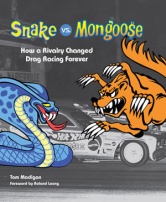 Snake vs Mongoose. Click image to enlarge |
By Russell Purcell
There have been many great driver rivalries on the track: Formula 1 gave us Prost versus Senna, NASCAR gave us Earnhardt versus Gordon, and the competitive tension between Casey Stoner and Valentino Rossi is the flavour of the day in Moto GP. The sport of drag racing has had its share of competitive match-ups, but there was one in particular that changed the face of the sport: Snake versus Mongoose.
If you’ve ever attended a motor sport event you probably immediately noticed that marketing represents the lifeblood for these high-octane endeavours. Every prominent surface or structure is wrapped in signage and banners; flags and pennants compete with tethered blimps and balloons for valuable airspace above the grandstands and paddock; race vehicles and tow rigs sport the colours and logos of their corporate sponsors; and not to be lost in this sea of communication, the drivers and crew personnel wear uniforms embroidered so heavily with promotional shrapnel that thread count statistics are impossible to tally.
This has not always been the case, especially in the early days of professional drag racing – a segment of the growing car culture that seemed to get lost in the shuffle when it came to gaining widespread acceptance and consumer awareness.
As speeds rose so did costs, and by the late 1960s the two figures began to escalate beyond the means of many members of the drag racing fraternity. Luckily, the arrival of two men on the burgeoning California scene – Tom “The Mongoose” McEwen and Don “The Snake” Prudhomme – would herald a new era in drag racing and change the sport forever.
McEwen and Prudhomme were both managing to eke out a living by running Top Fuel dragsters full-time at tracks across the state. The two friends and rivals quickly became fan favourites, and with their new found popularity corresponding with the emergence of the Funny Car category, the timing couldn’t have been better. Unlike the dart-like dragsters these two men were accustomed to racing, these full-bodied machines offered a canvas on which sponsors could showcase their product and brand names before grandstands full of people.
After a crewmember began calling Don Prudhomme the Snake (some believe due to his fast reflexes), noted racer and car builder Ed “The Mole” Donovan branded McEwen the Mongoose in an effort to counter Prudhomme’s rising popularity and give the growing legions of fans something to cheer for. It was Tom McEwen who came up with the original idea to approach Mattel to create toy cars to help promote himself, Prudhomme, and the sport of drag racing itself, as their carefully crafted rivalry was getting a great deal of media coverage that he felt they should capitalize on.
In 1968, Mattel created the very first Hot Wheels cars. The first releases “emphasized speed and wild designs,” and took their inspiration from the custom cars that were so popular in California during that period. As a result, McEwen’s idea was a hit and would be embraced by Mattel boss Larry Wood. This interesting collaboration would establish the Mattel Toy Company as the first non-automotive company to sponsor a drag racing team.
Designer Larry Wood gave up a career at Lockheed Aircraft to design toy cars at Mattel, and he became the man responsible for developing the various Snake and Mongoose game sets for the company during the three-year period of the program. I was surprised to learn that Mr. Wood’s design work entailed taking measurements of the real car’s actual chassis and body, as even today, the majority of Mattel’s small-scale die-cast offerings are pretty basic.







 Follow Autos on Twitter
Follow Autos on Twitter



